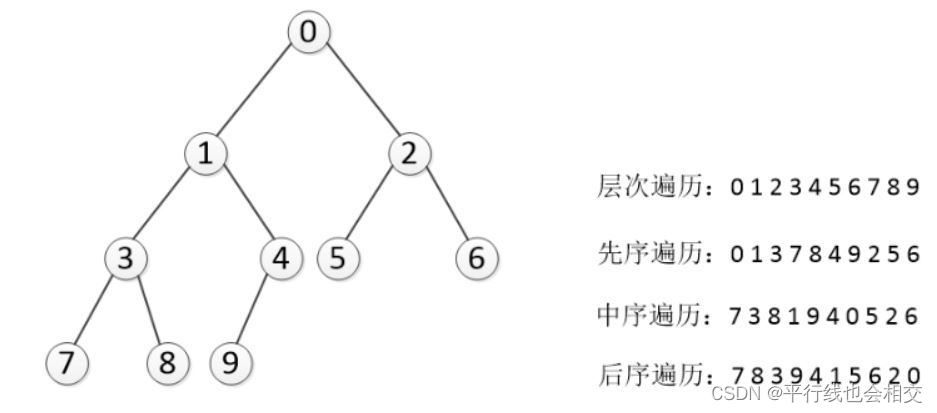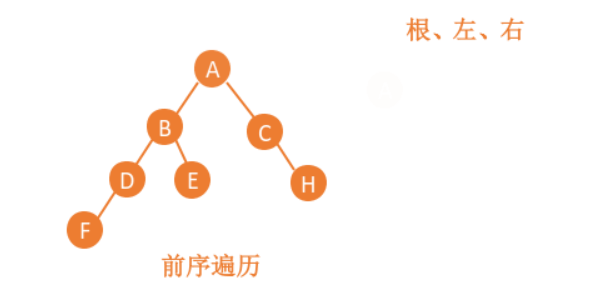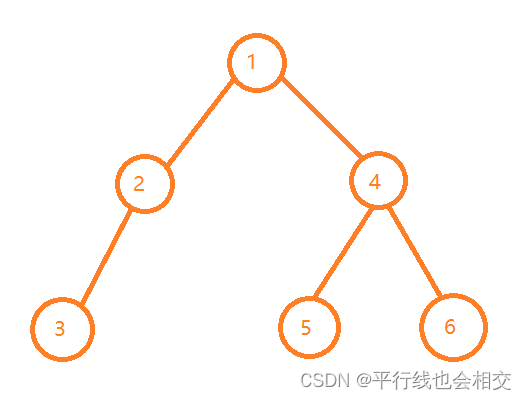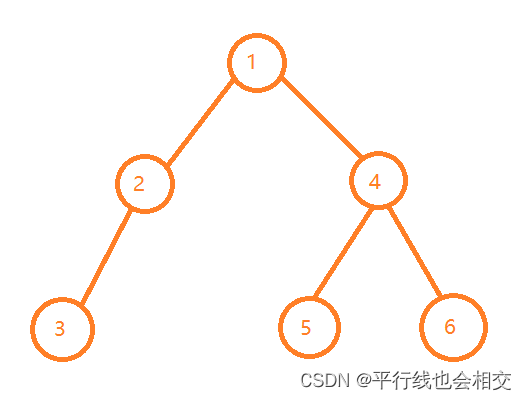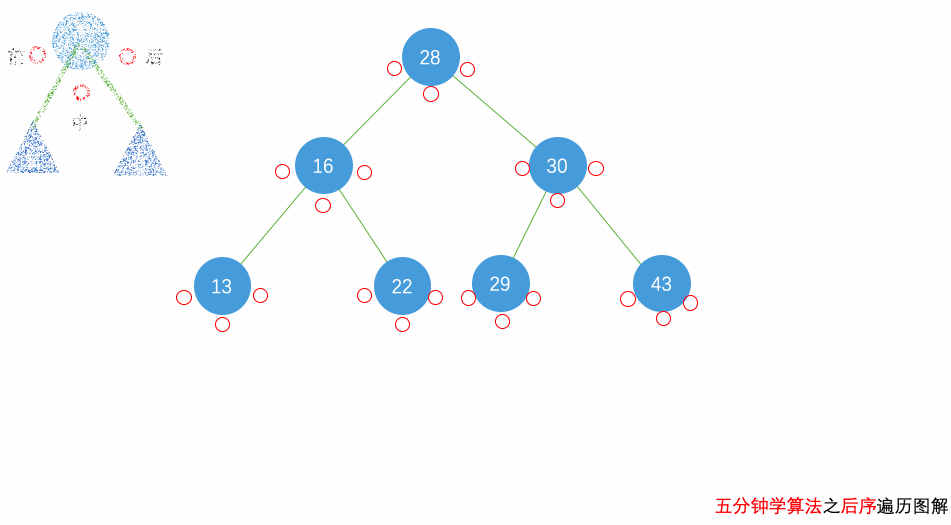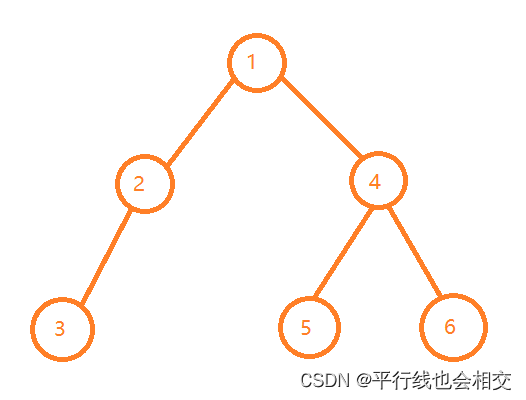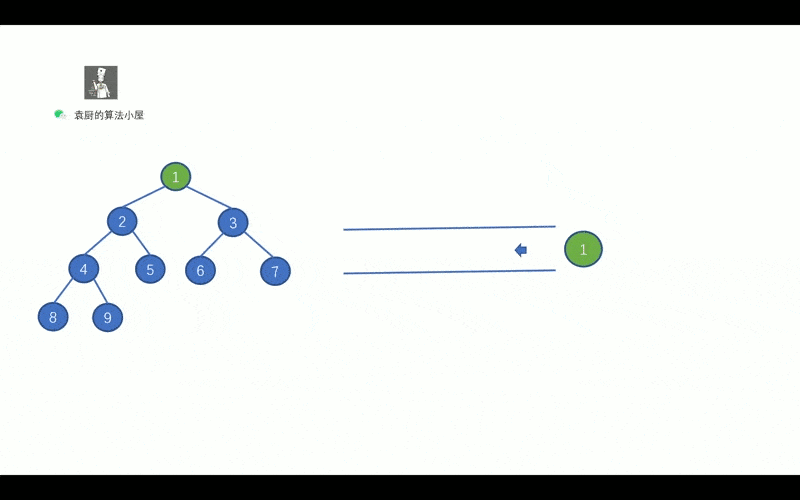二叉树遍历
什么是二叉树遍历:
二叉树遍历就是按照某种特定的规则,依次堆二叉树中的结点进行相应的操作,并且每个结点只操作一次。访问结点所做的操作依赖于具体的应用问题。遍历是二叉树上最重要的运算之一,也是二叉树上进行其它运算的基础。
我们以后看到二叉树应该这样去看待:把他看成根、左子树、右子树。
二叉树的遍历有:前序、中序、后序、层序遍历的递归结构遍历:
1.前序遍历(Preorder Traversal),也叫前根遍历:
2.中序遍历(Inorder Traversal),也叫中根遍历:
3.后序遍历(Post orderTraversal)也叫后根遍历:
4.层序遍历
前序遍历
下面是前序遍历的动态图。
以下图为例进行代码的编写:
请看代码:
void PreOrder(BTNode* root) { if (root == NULL) { printf("NULL "); return; } printf("%d ", root->data); PreOrder(root->left); PreOrder(root->right); }
这是运行结果:
中序遍历
请看中序遍历的动态图:
还是以下图进行举例:
请看代码:
//中序遍历 void InOrder(BTNode* root) { if (root == NULL) { printf("NULL "); return; } InOrder(root->left); printf("%d ", root->data); InOrder(root->right); }
下面是运行结果:
后序遍历
下面是后序遍历的动态图:
还是以下图进行举例:
//后序遍历 void PostOrder(BTNode* root) { if (root == NULL) { printf("NULL "); return; } PostOrder(root->left); PostOrder(root->right); printf("%d ", root->data); }
请看运行结果:
前中后序总代码
#define _CRT_SECURE_NO_WARNINGS 1 #include<stdio.h> #include<stdlib.h> #include<assert.h> typedef int BTDataType; typedef struct BinaryTreeNode { BTDataType data; struct BinaryTreeNode* left; struct BinaryTreeNode* right; }BTNode; //新建结点 BTNode* BuyNode(BTDataType x) { BTNode* node = (BTNode*)malloc(sizeof(BTNode)); if (node == NULL) { perror("malloc fail"); return NULL; } node->data = x; node->left = NULL; node->right = NULL; return node; } BTNode* CreatTree() { BTNode* node1 = BuyNode(1); BTNode* node2 = BuyNode(2); BTNode* node3 = BuyNode(3); BTNode* node4 = BuyNode(4); BTNode* node5 = BuyNode(5); BTNode* node6 = BuyNode(6); node1->left = node2; node1->right = node4; node2->left = node3; node4->left = node5; node4->right = node6; return node1; } //前序遍历 void PreOrder(BTNode* root) { if (root == NULL) { printf("NULL "); return; } printf("%d ", root->data); PreOrder(root->left); PreOrder(root->right); } //中序遍历 void InOrder(BTNode* root) { if (root == NULL) { printf("NULL "); return; } InOrder(root->left); printf("%d ", root->data); InOrder(root->right); } //后序遍历 void PostOrder(BTNode* root) { if (root == NULL) { printf("NULL "); return; } PostOrder(root->left); PostOrder(root->right); printf("%d ", root->data); } int main() { BTNode* root = CreatTree(); //PreOrder(root);//前序遍历 //InOrder(root);//中序遍历 //PostOrder(root);//后序遍历 return 0; }
最后,其实前序、中序、后序的过程基本上就是一样的,即前序、中序、后序的递归过程是一样的,不一样的就是访问根的时机不一样。
层序遍历
层序遍历的话可以利用队列先进先出的特点来进行实现,出上一层,带入下一层。
所以这里的层序遍历就是利用队列来实现的。
注意队列中的结点里面的data存的是树结点的指针。
层序遍历总代码
Quene.h
#pragma once #include<stdio.h> #include<stdlib.h> #include<assert.h> #include<stdbool.h> typedef struct BinaryTreeNode* QDataType; typedef struct QueueNode { struct QueueNode* next; QDataType data; }QueueNode; typedef struct Queue { QueueNode* head; QueueNode* tail; }Queue; void QueueInit(Queue* pq); void QueueDestory(Queue* pq); void QueuePush(Queue* pq,QDataType x);//插入数据 void QueuePop(Queue* pq);//删除数据 QDataType QueueFront(Queue* pq);//取队头的数据 QDataType QueueBack(Queue* pq);//取队尾的数据 int QueueSize(Queue* pq);//有多少个数据 bool QueueEmpty(Queue* pq);//判断队列是否为空
Queue.c
#define _CRT_SECURE_NO_WARNINGS 1 #include"Queue.h" //初始化 void QueueInit(Queue* pq) { assert(pq); pq->head = NULL; pq->tail = NULL; } void QueueDestory(Queue* pq) { assert(pq); QueueNode* cur = pq->head; while (cur) { QueueNode* next = cur->next; free(cur); cur = cur->next; } pq->head = pq->tail = NULL; } void QueuePush(Queue* pq, QDataType x) { assert(pq); QueueNode* newnode = (QueueNode*)malloc(sizeof(QueueNode)); newnode->data = x; newnode->next = NULL; if (pq->head == NULL) { pq->head = pq->tail = newnode; } else { pq->tail->next = newnode; pq->tail = newnode; } } //删除 void QueuePop(Queue* pq) { assert(pq); assert(!QueueEmpty(pq)); //if (pq->head == NULL) //{ // return; //}//温柔的处理 QueueNode* next = pq->head->next; free(pq->head); pq->head = next; if (pq->head == NULL) { pq->tail=NULL; } } bool QueueEmpty(Queue* pq) { assert(pq); return pq->head == NULL; } QDataType QueueBack(Queue* pq)//取队尾的数据 { assert(pq); assert(!QueueEmpty(pq)); return pq->tail->data; } QDataType QueueFront(Queue* pq)//取队头的数据 { assert(pq); assert(!QueueEmpty(pq)); return pq->head->data; } int QueueSize(Queue* pq)//有多少个数据 { assert(pq); int n = 0; QueueNode* cur = pq->head; while (cur) { n++; cur = cur->next; } return n; }
test.c
#define _CRT_SECURE_NO_WARNINGS 1 #include<stdio.h> #include<stdlib.h> #include<assert.h> #include"Queue.h" typedef int BTDataType; typedef struct BinaryTreeNode { BTDataType data; struct BinaryTreeNode* left; struct BinaryTreeNode* right; }BTNode; //新建结点 BTNode* BuyNode(BTDataType x) { BTNode* node = (BTNode*)malloc(sizeof(BTNode)); if (node == NULL) { perror("malloc fail"); return NULL; } node->data = x; node->left = NULL; node->right = NULL; return node; } BTNode* CreatTree() { BTNode* node1 = BuyNode(1); BTNode* node2 = BuyNode(2); BTNode* node3 = BuyNode(3); BTNode* node4 = BuyNode(4); BTNode* node5 = BuyNode(5); BTNode* node6 = BuyNode(6); node1->left = node2; node1->right = node4; node2->left = node3; node4->left = node5; node4->right = node6; return node1; } //前序遍历 void PreOrder(BTNode* root) { if (root == NULL) { printf("NULL "); return; } printf("%d ", root->data); PreOrder(root->left); PreOrder(root->right); } //中序遍历 void InOrder(BTNode* root) { if (root == NULL) { printf("NULL "); return; } InOrder(root->left); printf("%d ", root->data); InOrder(root->right); } //后序遍历 void PostOrder(BTNode* root) { if (root == NULL) { printf("NULL "); return; } PostOrder(root->left); PostOrder(root->right); printf("%d ", root->data); } int size = 0; 求树中结点个数法1 //int TreeSize(BTNode* root,int* psize) //{ // if (root == NULL) // return; // (*psize)++; // TreeSize(root->left, psize); // TreeSize(root->right, psize); //} //求树的结点个数法2 int TreeSize(BTNode* root) { return root == NULL ? 0 : TreeSize(root->left) + TreeSize(root->right) + 1; } //求树的高度 int TreeHeight(BTNode* root) { if (root == NULL) return 0; int leftHeight = TreeHeight(root->left); int rightHeight = TreeHeight(root->right); return leftHeight > rightHeight ? leftHeight + 1 : rightHeight + 1; } int TreeKLevel(BTNode* root, int k) { if (root == NULL) return 0; if (k == 1) return 1; int leftK = TreeKLevel(root->left, k - 1); int rightK = TreeKLevel(root->right, k - 1); return leftK + rightK; } //二叉树查找值为x的结点 BTNode* BinaryTreeFind(BTNode* root, BTDataType x) { if (root == NULL) return NULL; if (root->data == x) return root; BTNode* lret = BinaryTreeFind(root->left, x); if (lret) return lret; BTNode* rret = BinaryTreeFind(root->right, x); if (rret) return rret; return NULL; } //层序遍历 void LevelOrder(BTNode* root) { Queue q; QueueInit(&q); if (root) QueuePush(&q, root); while (!QueueEmpty(&q)) { BTNode* front = QueueFront(&q); //front指向的不是队列的结点,而是树的结点 QueuePop(&q); printf("%d ", front->data); if (front->left) QueuePush(&q, front->left); if (front->right) QueuePush(&q, front->right); } QueueDestory(&q); } int main() { BTNode* root = CreatTree(); //PreOrder(root);//前序遍历 //InOrder(root);//中序遍历 //PostOrder(root);//后序遍历 求树的结点法1 /*int size1 = 0; TreeSize(root, &size1); printf("TreeSize:%d\n", size1); int size2 = 0; TreeSize(root, &size2); printf("TreeSize:%d\n", size2);*/ 求树的结点法2 //printf("TreeSize:%d\n", TreeSize(root)); //printf("TreeSize:%d\n", TreeSize(root)); //printf("TreeSize:%d\n", TreeSize(root)); 求树的高度 //printf("TreeHeight:%d\n", TreeHeight(root)); //printf("TreeKLevel:%d\n", TreeKLevel(root, 1)); 二叉树查找值为x的结点 //printf("BinaryTreeFind:%p\n", BinaryTreeFind(root, 5)); //printf("BinaryTreeFind:%p\n", BinaryTreeFind(root, 0)); //层序遍历 LevelOrder(root); return 0; }
以上就是二叉树遍历的四种方式(前序、中序、后序、层序)。说实话,内容还是有些难度的,这就更需要我们认真的进行学习并复习了。
加油,各位!!!
